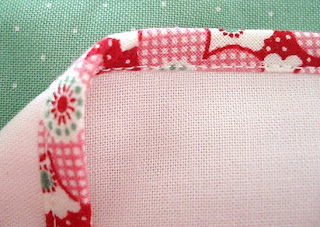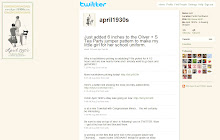SweetPea would pick out the fabric and buttons to accommodate each person on her list depending on the relationship and then she and I came up with some generic phrases for her to copy using a fabric ink pen. I would finish with hand embroidery following her own handwriting. Granted, I asked for the class list about a month ahead of time so we could have ample time to prepare, but it was quite fun come delivery day.
Monday, February 13, 2012
Happy Valentine's
SweetPea would pick out the fabric and buttons to accommodate each person on her list depending on the relationship and then she and I came up with some generic phrases for her to copy using a fabric ink pen. I would finish with hand embroidery following her own handwriting. Granted, I asked for the class list about a month ahead of time so we could have ample time to prepare, but it was quite fun come delivery day.
Wednesday, November 09, 2011
Merry Christmas Trinket Boxes

Several years ago I was meandering through an antique store near Seattle, Washington. It was at Two French Hens in Burien if you desire to have a peek there sometime - they have the sweetest offerings!
Anyway, I stumbled upon an old stationery box with various old cards -- in it were these little cards so-to-speak that were delicately preserved with their original ribbons and even their envelopes so as to be mailed! The cards were from the early 1900's with crow-quill & ink penned names ~ there was one for Earle, Glen, Ronald, and H.E. Bailey. The rest of the cards were all blank. Of course the cards were quite fragile, but I determined then and there to replicate and offer them to others. They were just too sweet not to share!
With Christmas around the corner, I wanted everyone to have these to use in plenty of time for Holiday gatherings and gift-giving exchanges.
I am calling them the Merry Christmas Trinket Boxes.... enjoy!
 Click on the photo above for the free PDF download and step-by-step photograph tutorial with assembly instructions.
Click on the photo above for the free PDF download and step-by-step photograph tutorial with assembly instructions.
Tuesday, August 02, 2011
Clothes Pin Dolls
Step 1: Fold a little edge of a square or rectangular fabric scrap and pin it with the clothes pin.
Step 2: Flip the clothes pin down.
Step 3: Wrap the fabric corners to the center around the clothes pin.
Step 4: Tie a piece of bias tape, yarn, or string around the clothes pin for the neck scarf.
Optional Step 5: (Little Girls like this one, particularly) Draw a face.
You can pink the fabric edges, too, if you want a frilly hem.
Have fun!
Wednesday, February 09, 2011
Singer Tucker Attachment Video Tutorial
How to sew pintucks using an old-fashioned Singer Tucker Attachment.
Demonstration was with a Singer Featherweight 222 Sewing Machine.
Friday, February 04, 2011
Bias Cutting Tutorial
Sometimes I have a little piece of fabric leftover from a project, but not enough to cut long strips for bias trim - and it would be tedious to sew several small strips together. Other times I want to conserve every last fiber of yardage because of the fabric rarity or cost. I have a feeling I will be using this technique often for my Liberty remnant prints!
To begin, cut a parallelogram shape from fabric with the long sides being cut on the bias and the short sides being cut on the straight of grain.
(as indicated by the grid on the cutting mat)
On the back side of the fabric piece measure and mark your bias strips to your desired width. It does not matter what width you prefer, this technique is applicable for any bias width desired.
NOTE: You will need to have one full width of bias (which will NOT get stitched) on at least one end when you pin it together as indicated by the previous two pictures in the tutorial.
Notice the red stitching in the photo above? I stopped just short of the last full width of bias. There is now a full bias width that was not stitched as indicated in previous photo instructions. (the extra little width on the right side is just excess and will get cut off)
My 8 x 18 inch fabric piece yielded 82 inches of one-inch bias!
Friday, January 28, 2011
Flat Felled Seams - Tutorial
This tutorial was featured on the Oliver + S blog.
A flat-felled seam is accomplished by sewing two lines of stitching at the seam while simultaneously enclosing the raw edges of the fabric. This seam finish not only prevents unraveling or fraying, but makes the seam very strong. It also gives the finished garment a clean finish on this inside. A flat-felled seam is commonly found on denim jeans and men's dress shirts as well as on reversible garments. I've even seen this feature instructed in vintage patterns for boy's and men's pajamas. It adds one more touch of professionalism to a hand-made garment.
To begin, stitch the seam with the fabric pieces wrong sides together. You can determine how wide you want your flat-felled seam to be by how much you trim your seam allowances. Begin by trimming only one side to the desired width of the finished seam allowances.
Trim the second seam allowances to twice the width of the first. For this example, I stitched a ½” seam and then trimmed the first seam allowance to ¼”, which means I didn’t need to trim the second seam allowance since it was already twice the width of the first.
Fold and press the wider seam allowance around the shorter seam allowance so the raw edge of the second (wider) seam allowance meets the first seam line. Then stitch along the folded edge of the second seam allowance. This encloses the raw edge, and with the second row of stitching creates a very strong seam.
To make my stitching rows evenly spaced, I used a 1/4-inch foot. The black guide on the right followed the first stitching line while the inside edge of the little toe was a guide for sewing the second stitching line.
~ ~ ~ ~ ~
Another useful tool is the Felling Foot, because it folds, presses, and stitches the first row of stitches all in one pass. Using this attachment, while still accommodating a 1/2-inch seam allowance, I trimmed 1/8 inch from each of the seam allowances prior to stitching so that the finished seam would finish with the correct seam allowance according to the pattern.
To begin, space the top seam allowance 1/8 inch to the left of the bottom seam allowance as shown in the photo above. Finger press and fold the start of the seam so that you can stitch 2-3 stitches to secure the folds in place. With the needle still in position, maneuver the bottom seam allowance into the Felling foot so that it curves up and around - sewing slowly, carefully begin stitching to allow the bottom seam allowance to fold over the top seam allowance so that the folds can be stitched in place for the first stitching line.
Simultaneously, the attachment is folding, pressing and allowing the needle to stitch the initial seam enclosed. Press the enclosed seam so that you can make the final pass with the attachment.
Using the Feller attachment for the second pass, slip the stitched fold up into the attachment with the right toe set up against the outside of the first row of stitches. Allow the fold to carefully pass under the foot while stitching it in place for the finished Flat-Felled Seam. The 4mm Feller Attachment makes a dainty, 1/8" narrow flat-felled seam.
Monday, September 20, 2010
Seam Finishes - Bound Seams
Bias Binding is a strip of material cut on the bias for extra stretch and often doubled. It is used for binding hems, interfacings or for edge decoration and is very useful for many sewing projects. It adds a touch of embellishment to set your garment or project apart for a more professional appearance. You can purchase ready-made bias or make your own. Bias-making tools are helpful and efficient, but a good steam iron is the necessary tool! I personally prefer to make my own because I can customize it to my project, but some of the old-fashioned vintage unused packages can be quite fun to put to use, too! The focus of this tutorial will be set around making your own bias.

The Bias Strip is guided through the attachment while simultaneously being folded, stitched in place and enclosing the raw edge of the seam allowances. You can use this attachment for a variety of bias-width cuts, but the maximum width allowed through the binder is 15/16".









